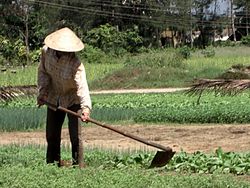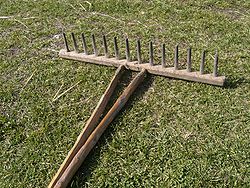- This is Section 4 of the Gardening Seminar:Start your own garden. Comments or questions are appreciated. You can also write to John Eagles.
Make your gardening more enjoyable and easy by using the right tools for each job! For a small garden you can do with fewer tools but if your garden is bigger, it pays off to buy more tools and to learn using and applying them in the right way.
To loosen a soil there are various tools. There's the normal spade, but you can also use a heavy hoe, a hand cultivator or a 'grelinette.' I use a grelinette or garden fork more than a spade, as the work is easier, especially because with a grelinette the soil layers aren't disturbed, meaning that the top soil which contains more oxygen-loving micro-organisms and more humus remains top soil.
For weeding you can use a hand cultivator, a normal hoe or a push hoe. You've got to try out which one of these works best for your soil. I use several types of hoes and several types of push hoes, depending on how hard the soil is and how thick and high the weeds. Narrower hoes are good to go in-between lines with crops while wider hoes work faster when you have more space.
Browse through the gallery and make yourself familiar with the different types of garden tools. For further reading go to the external links below.
A gallery of common garden tools
- See the External links below for more information about these tools
Push hoe to cut weeds just under the surface
Different types of hoes to control weeds by agitating the surface of the soil around plants, piling soil around the base of plants (hilling), creating narrow furrows (drills) and shallow trenches for planting seeds and bulbs, to chop weeds, roots and crop residues
Heavy hoe to dig or move soil
Spades for digging or removing earth, the small one for clay soil, the other one for sandy soil and loamy soil
Hand rake for loosening the soil, light weeding and leveling, removing dead grass and weeds from gardens
Grass rake for leaves and grass
Edger to cleanly separate a lawn from a walkway or borders with vegetables and flowers.
Two of my hand cultivators with different lengths of the handles. Hand cultivators are used to stir the soil, either before planting to aerate the soil and prepare a smooth, loose seedbed or after the crop has begun, also to aerate the soil and to kill weeds.
A garden fork, spading fork, digging fork or graip is used for loosening, lifting and turning over soil in gardening and farming. It is used similarly to a spade.
A digging fork or 'grelinette' with five teeth. It is used for loosening, lifting and turning over soil in gardening and farming. It has the advantage that it doesn't disturb the layers in the soil.
One-pin grelinette or garden fork, works deeper than the ordinary grelinette or garden fork
Motorized cultivator or tiller. It can perform many functions such as plowing, cultivating and tilling of the soil. Rototilling is much faster than manual tilling, but exhausting work, especially when using the heavier models.
A pitchfork next to a compost bin. It is used to lift and pitch (throw) loose material, such as hay, leaves, dung or other agricultural materials.
Pruning shears are used to prune hard branches of trees and shrubs, sometimes up to two centimetres thick.
Loppers - Loppers are a type of scissors used for pruning twigs and small branches. They are the largest type of manual garden cutting tool. They are usually operated with two hands, and with handles around 65 cm long to give good leverage.
The billhook is used for cutting smaller woody material such as shrubs and branches.
A hand drill to make holes for poles to fix fences
A manual hedge trimmer. There also exist several types of motorized hedge trimmers.
A scythe is for mowing grass, or reaping crops. I use one like shown in the picture and a smaller one to cut grass in difficult corners.
A wheelbarrow is a device to carry loads.
Back
Next section
See also
External links
- Coming soon




















